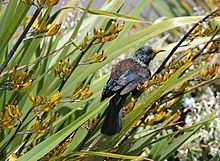Phormium colensoi
| Phormium colensoi | |
|---|---|
 |
|
| Mountain flax being visited by a tui | |
| Scientific classification | |
| Kingdom: | Plantae |
| Clade: | Angiosperms |
| Clade: | Monocots |
| Order: | Asparagales |
| Family: | Asphodelaceae |
| Subfamily: | Hemerocallidoideae |
| Genus: | Phormium |
| Species: | P. colensoi |
| Binomial name | |
|
Phormium colensoi Hook.f. |
|
| Synonyms | |
|
|
Phormium colensoi (syn. Phormium cookianum; mountain flax, lesser New Zealand flax, or wharariki in Māori) is a perennial plant that is native to New Zealand. It is less common than the other Phormium species, P. tenax. The greenish, yellow or orange flowers are followed by twisted seed pods.
The leaves are under 2 metres in length while those of P. tenax range from 1 to 3 metres in length. The scape is much shorter than that of P. tenax, rising up to 2 metres in height while that of P. tenax is around 5 metres in height. The colour of the inner tepals is green while the outer tepals are yellow to red. In contrast the tepals of P. tenax are a dull red, with the tips of the inner tepals being less strongly recurved. The capsules of P. colensoi, unlike those of P. tenax are twisted and pendulous, and may be twice as long (up to 20 cm in length).
Phormium colensoi has two distinct geographic forms, one occurring in lowland parts of the North Island, and the other in the southern and mountainous areas of the South Island as well as ranges in the North Island. The lowland form has green or yellow tepals and the mountain form has red tepals. In the Cook Strait area, both forms and intermediates can be found.
The species was originally mentioned without description by William Colenso, the name being given as Phormium forsterianum. It was later known as P. colensoi, a name that was listed without description in 1846 by J. D. Hooker. The name became better known from J. D. Hooker's 1864 publication in Handbook of the New Zealand Flora. However, previously, in 1848, Auguste François Le Jolis had described the species under the name P. cookianum, and for many years this name was thought to have priority over Hooker's name P. colensoi. The latter is now regarded as the accepted name, based on a brief description of the species in a quotation from J.D. Hooker in an article by Auguste Le Jolis in the Revue Horticole of 1 January 1848. Another specimen, believed to be identical to a plant found by Ronald Gunn at the Whanganui River in 1864, was described from a plant growing in a garden in Torquay, England in 1888 and given the name P. hookeri (later reduced to a subspecies under the name P. cookianum subsp. hookeri). This name is also now regarded as a synonym of P. colensoi.
...
Wikipedia
